Google Nexus 4 Review - Google's new Flagship
by Brian Klug on November 13, 2012 8:45 AM EST- Posted in
- Smartphones
- LG
- Android
- Mobile
- APQ8064
- Nexus 4
- Android 4.2
- MDM9215
Cellular, Wi-Fi, GNSS
Let’s talk about cellular on the Nexus 4, which is for many people the main point of contention with the device. Google didn’t do itself any favors by initially posting incorrect specs for cellular compatibility, when in fact the Nexus 4 was capable of much more. Initially, that spec table showed inclusion of only HSDPA 21.1 (single-carrier WCDMA with 64 QAM), when in fact the Nexus 4 supports pentaband WCDMA up to HSDPA 42.2 (dual-carrier WCDMA with 64 QAM) courtesy of MDM9215. Of course, what gets left out is LTE support, and the reality of that choice is a device completely detached from carrier involvement. The realities of engineering hardware to support both LTE Bands 17 and 13 (for both AT&T and Verizon in the USA, respectively) basically necessitate at least two SKUs, and I have a feeling that Google just wasn’t ready to make that commitment. Band 4 (AWS) could essentially be supported with the power amplifiers and transceiver that already are onboard the Nexus 4, but again it ultimately comes down to a particular OEM choice whether these get supported. The rest of the LTE band support situation is similarly complicated, to say nothing of the political involvement required to support LTE and whatever CSFB (circuit switched fallback) or legacy hard handover is required for each carrier at present. I have a feeling that Google wanted to get the Nexus 4 out the door quickly and without making a million and one models it would have to build images and OTA delta updates for, and the result is a pentaband WCDMA phone with DC-HSPA+ support.
When I heard that LG would be making the next Nexus, I also heard that it would be WCDMA only. Honestly I thought it was obvious that those two go hand in hand to minimize carrier involvement in Google’s purest form of Android. The original goal of Nexus was to change the way that users shop for handsets, primarily in the USA. The goals were lofty at that time and the reality was that Google didn’t yet have the necessary infrastructure (like the Play Store) to do it, nor was hardware at the level required to deliver a single-SKU solution for all the UMTS bands out there. Galaxy Nexus was the first pentaband Nexus, thus it only makes sense for the follow up to likewise be pentaband WCDMA.
Internationally, DC-HSPA+ has widespread support, the reality is that in the USA AT&T’s lack of support for DC-HSPA+ is more of an aberration than the norm for UMTS networks across the globe. Not having LTE support would be much easier to stomach for AT&T subscribers if the carrier enabled DC-HSPA+. T-Mobile has always been something of a silent (or not so silent) target for Google’s Nexus phones, with the G1, Nexus One, and Nexus S all coming in AWS-flavors before 850/1900 (Cellular/PCS) flavors for AT&T, and T-Mobile has had DC-HSPA+ rolled out to nearly all of its WCDMA footprint for months now.
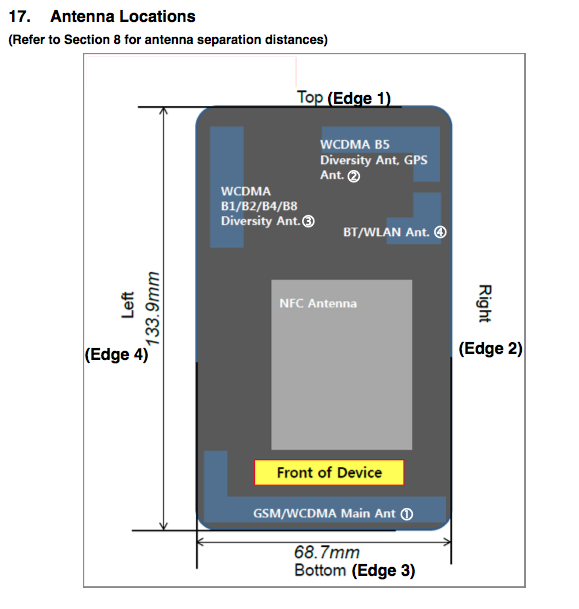
In reality, the cellular and RF architecture of the Nexus 4 is a dramatic improvement over the Galaxy Nexus, which was based on the still-ubiquitous Intel XMM6260 65nm baseband and lacked receive diversity or interference cancelation in its implementation. I was never really fully satisfied with RF performance on the Galaxy Nexus, and although I carried it as my daily driver for months, I could never shake that thought at the back of my head that I could definitely be achieving higher throughput with almost any of my other handsets even on AT&T (up to HSDPA 14.4, single carrier 16 QAM).
| Google Nexus 4 - Network Support | |||||
| GSM/EDGE Support | 850 / 900 / 1800 / 1900 MHz | ||||
| WCDMA Support | 850 / 900 / 1700 / 1900 / 2100 MHz | ||||
| Baseband Hardware | Qualcomm MDM9215M + WTR1605L | ||||
| UE Categories | HSDPA Category 24 (43.2 Mbps), HSUPA Category 6 (5.76 Mbps) | ||||
Anyhow, the Nexus 4 is a dramatic improvement. It includes the latest and greatest 28nm Qualcomm baseband (MDM9215M), their flagship transciever (WTR1605L) and includes full receive diversity on all WCDMA bands.
Anritsu recently loaned me an MD8475A signaling tester base station emulator for testing devices, and I decided to go and check out the maximum theoretical performance difference between the Galaxy Nexus and Nexus 4 just for illustrative purposes. In this test I corded up the Galaxy Nexus (since it has external antenna ports) and placed the Nexus 4 on top of an antenna, and setup a simulation running an HSPA+ 3GPP Release 8 network running on UMTS Band 4 (AWS). I tested using UDP over iperf on this simulated network. There were additional cabling losses due to me not being able to cable up the Nexus 4 so I adjusted Tx power appropriately.
Nexus 4 - HSDPA 42.2 (Dual Carrier)
Corded up, the Galaxy Nexus can eek out just over 19 Mbps on 64QAM single carrier WCDMA which is the maximum that hardware supports. Moving to dual carrier on the Nexus 4 buys the device unsurprisingly roughly double the throughput at just shy of 40 Mbps. This is of course in basically an ideal signal environment for both devices.
In real world performance testing I turned to speedtest.net and running a bunch of tests, then making a few histograms of the resulting data. I’m still a big fan of the fact that T-Mobile has always been first to these upgrades to WCDMA, first with 64QAM, then with dual carrier (DC-HSPA+).
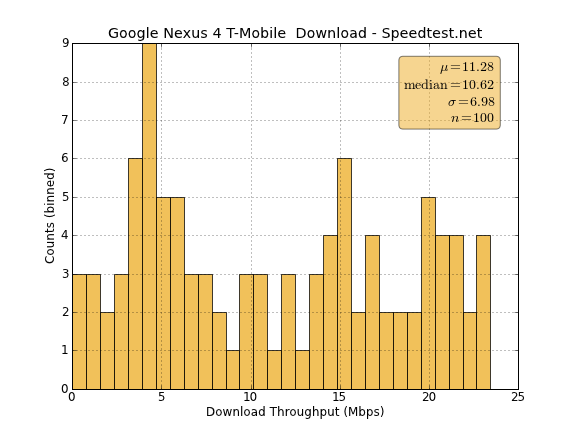
Stats Download Throughput (Mbps) Avg: 11.28, Max: 23.43, Min: 0.01, StDev: 6.98
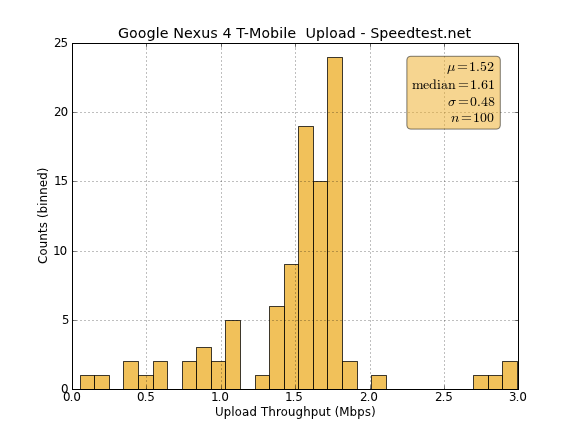
Stats Upload Throughput (Mbps) Avg: 1.52, Max: 2.99, Min: 0.05, StDev: 0.48
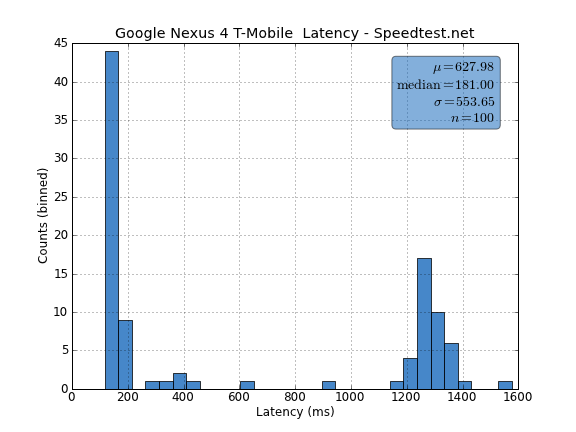
Stats Latency (ms) Avg: 627.98, Max: 1577.00, Min: 117.00, StDev: 553.65
The speeds I see out of the Nexus 4 on T-Mobile are on par with my expectations for that network. The maximum downstream throughput we see at just shy of 24 Mbps is essentially the result of the maximum bitrate with two 16QAM WCDMA carriers aggregated together. Again getting to 64QAM on the downlink can be quite difficult, I’ve seen breakdowns where 64QAM only gets used sub 10% of the time in the real world for WCDMA. At cell edge the improvement that receive diversity brings should be dramatic for users upgrading from Galaxy Nexus to Nexus 4.
GNSS
GNSS (Global Navigation Satellite System) is supplied courtesy MDM9215 on the Nexus 4, which offers GPS and GLONASS support. I’ve talked at length about this in other reviews, and like other implementations based around Qualcomm’s GNSS, the Nexus 4 locks very fast even indoors. There’s really nothing more to add about GNSS on the Nexus 4 except to note that it performs very well just like other MDM9x15 based devices I’ve played with.
There’s an Avago 3012 GNSS front end with LNA and filters for GPS and GLONASS on the Nexus 4 PCB that I was able to identify as well right near the GNSS antenna feed.
Wi-Fi
The Nexus 4 includes dual band (2.4 and 5 GHz) Wi-Fi support, which as far as I can tell is supplied by the Qualcomm “WCNSS” solution leveraging the digital baseband onboard APQ8064 and some external RF. I have no doubt the actual package is hidden under the last remaining EMI can I couldn’t remove on the Nexus 4 PCB right near the Wi-Fi antenna feed.
I noted that there’s an optimization toggle under Advanced for the Nexus 4 which changes some things around. There still is a band preference toggle as well. I tested the Nexus 4 the same way I always do with iperf on my myriad 802.11n networks and made some graphs.
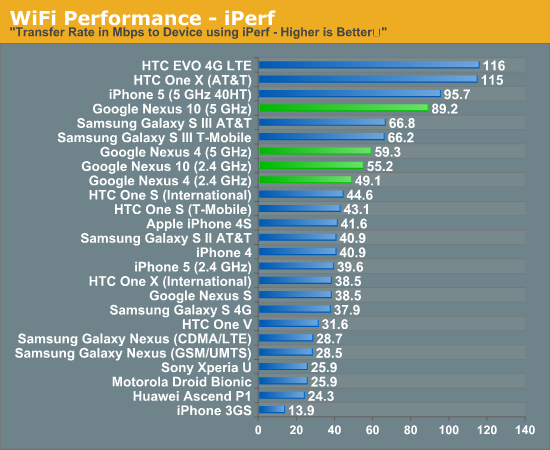
What’s curious to me is that the 5 GHz support for Nexus 4 doesn’t include 40 MHz support, instead the Nexus 4 attaches at 72 Mbps (the 20 MHz, short guard interval rate) on both 2.4 and 5 GHz. Likewise we see similar throughput on both bands. I have no complaints about range, the Nexus 4 is on par with my expectations.


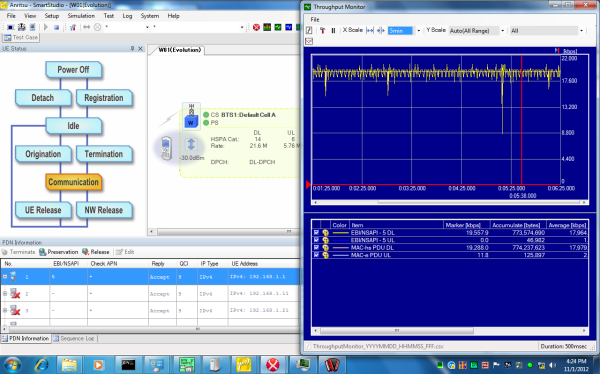
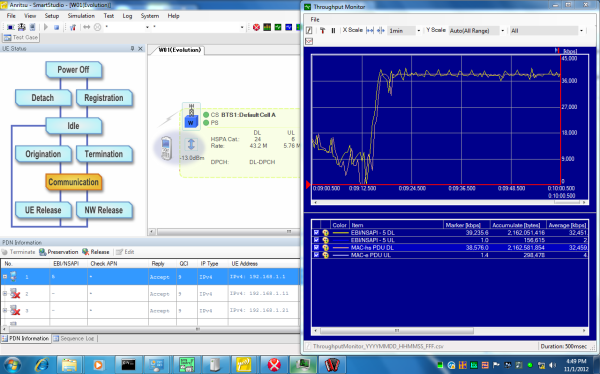








188 Comments
View All Comments
Rits - Tuesday, November 13, 2012 - link
Mean nothing in real life. The N4 flies through tasks in practical usage. Bring me an iPhone5 and show me how it is faster in any way. Synthetic benchmarks are, for the most part, useless. Esp, cross-platform ones.PeteH - Tuesday, November 13, 2012 - link
Depends. In most cases I agree with you, but if you're interested in a phone capable of, for example, playing state of the art (for a mobile device) games, certain graphical benchmarks are useful.Granted most users won't care about that, but most users don't read AnandTech.
lilmoe - Wednesday, November 14, 2012 - link
The iPhone 5 isn't faster, its software is more optimized. Chrome is well known to really "suck" in javascript and scrolling performance on Android. Even Dolphin Browser beats it in each performance category. Samsung's stock browser on the SGS3 is probably the best Android browser out there, I wonder how well it would perform on the Nexus 4's CPU. Chrome is nice for syncing bookmarks across all your devices in addition to some stuff, but otherwise, it really sucks.In the GPU benchmark tests where the A6 (PowerVR SGX543 MP3) beats the APQ 8064 (Snapdragon S4 Pro's Adreno 320), These are sub-scores (sub-tests) that don't really show the "big picture". They test the GPU of the platform for several shader-centric tasks. Those who use these benchmarks are looking for specific numbers for specific purposes.
What really matters in GLBenchmark for most consumers is the "Egypt Classic" and "Egypt HD" tests. These tests show the gaming/GPU performance of the platform as a whole, with the former testing "generic" 3D gaming capabilities, and the latter testing for the most modern demanding games (that stresses the platform/shaders for most fillrate, vertex, and compute performance. It's mostly over-kill and you wont see games demanding the same anytime soon). You'll easily achieve 60fps with any game you run on the Nexus 4 even with a higher resolution than the iPhone 5...
The Nexus 4 should prove to be better performing and more "future-proof" than the iPhone 5, since it has a faster CPU (quad core Krait VS dual core Swift) and a GPU that supports future standards like OpenGL ES 3.0, Open CL and Renderscript, unlike the PowerVR inside the A6 chip. Software optimization is a non-issue since it can be tuned-up in future updates or different browsers from Play Store in the case of the web browser.
There are lots of metrics to consider in cross-platform/cross-OS benchmarking, and there's absolutely NO benchmark that will show the true difference of performance among different platforms, especially with "Android VS Android" or "Android VS iOS" because each Android OEM utilizes different hardware and different software optimizations (in addition to other factors, like thermal throttling in this review's case). That's probably not the case when comparing the iPhone 5 versus the 4S or even a Windows Phone 8 devices versus another device running the same OS because both platforms use vertically integrated hardware/software, but that's where firmware and driver version differences start to kick in, but it's closer to reality than anything related to Android.
Red Oak - Tuesday, November 13, 2012 - link
And also, no LTE. Comical. Certainly for the US marketantef - Tuesday, November 13, 2012 - link
Not at half the price of other phones. Also Android and especially Nexus is an open platform, so that automatically shuts the door on CDMA and consequently the biggest LTE carrier in the US. Nobody who has good HSPA+ cares.Penti - Tuesday, November 13, 2012 - link
In Europe you get pretty good carrier support with just quad band LTE which is showing up now. All USIM, plus Band 7, Band 20, Band 8, Band 3 covers most here and is available in most countries. In Sweden we started on Band 7 and now runs networks at Band 20 and Band 8 too. So we can actually get devices now which runs on all the frequencies either in use or that will be refarmed. Similar in other countries here. Most carriers has a few bands. You do need to support more then one. More troublesome in the US obviously. It is looking up finally though. DC-HSPA+ is up an running too so, even in small communities. It's not bad, at least not if you are able to use wifi for heavier/larger stuff.antef - Tuesday, November 13, 2012 - link
Clearly the Nexus 4 is not named as such because it's the 4th Nexus phone like you mention. If that was the case the Nexus 7 and 10 would throw a wrench in that wouldn't it? It's named that way because the screen is 4(.7)". If you look at the Nexus logo on the site they even de-emphasize the number by making it a small superscript to "nexus" and saying "now in three sizes." The fact that it's the 4th Nexus is just a coincidence. I would expect them to keep these names going forward and just release a Nexus 4 2nd gen, 3rd gen, etc.Rits - Tuesday, November 13, 2012 - link
Correct.tarunactivity - Tuesday, November 13, 2012 - link
The iPhone 5 resolution is 1136x640-pixel , not 1136x960 ...http://www.apple.com/iphone/specs.html
stotticus - Tuesday, November 13, 2012 - link
Of what city are those pictures?